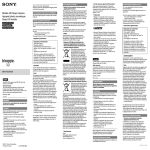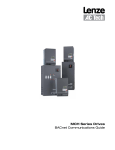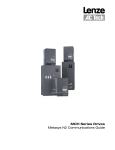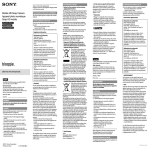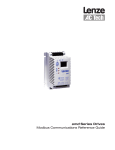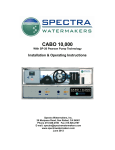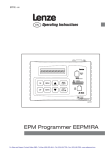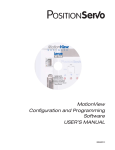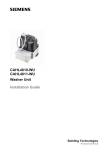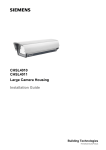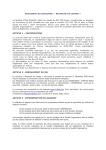Download MCH Series Siemens P1 Communications Reference
Transcript
MCH Series Drives Siemens P1 Communications Guide About These Instructions This documentation applies to the use of an MCH Series Variable Frequency Drive in a Siemens P1 Floor Level Network (FLN) and should be used in conjunction with the MCH Series Installation and Operation Manual (Document MH01) that shipped with the drive. These documents should be read in their entirety as they contain important technical data and describe the installation and operation of the drive. Siemens P1, System 600 and Apogee are trademarks of Siemens AG, Munich, Germany; http://w1.siemens.com. In the United States: http://www.usa.siemens.com © 2003 AC Technology Corporation No part of this documentation may be copied or made available to third parties without the explicit written approval of AC Technology Corporation. All information given in this documentation has been carefully selected and tested for compliance with the hardware and software described. Nevertheless, discrepancies cannot be ruled out. AC Tech does not accept any responsibility nor liability for damages that may occur. Any necessary corrections will be implemented in subsequent editions. Contents 1 Safety Information..............................................................................................................1 1.1 Warnings, Cautions and Notes...............................................................................1 1.1.1 General.....................................................................................................1 1.1.2 Application................................................................................................1 1.1.3 Installation................................................................................................1 1.1.4 Electrical Connection.................................................................................2 1.1.5 Operation..................................................................................................2 2 Introduction........................................................................................................................3 2.1 Floor Level Network Communications....................................................................3 2.2 Hardware Description............................................................................................3 2.3 Serial Communications Wiring...............................................................................3 3 Drive Setup and Programming............................................................................................4 3.1 Added Programming Parameters...........................................................................4 3.2 Omitted Parameters and Selections.......................................................................4 3.3 Modified Programming Parameters........................................................................5 3.4 Serial Communications Setup................................................................................5 4 MCH P1 Points...................................................................................................................7 4.1 MCH P1 Point Map.................................................................................................7 4.2 MCH P1 Point Descriptions....................................................................................8 4.3 Reference and Links..............................................................................................12 i RG-MHSP1F Safety Information 1 Safety Information 1.1 Warnings, Cautions and Notes 1.1.1 General Some parts of Lenze controllers (frequency inverters, servo inverters, DC controllers) can be live, moving and rotating. Some surfaces can be hot. Non-authorized removal of the required cover, inappropriate use, and incorrect installation or operation creates the risk of severe injury to personnel or damage to equipment. All operations concerning transport, installation, and commissioning as well as maintenance must be carried out by qualified, skilled personnel (IEC 364 and CENELEC HD 384 or DIN VDE 0100 and IEC report 664 or DIN VDE0110 and national regulations for the prevention of accidents must be observed). According to this basic safety information, qualified skilled personnel are persons who are familiar with the installation, assembly, commissioning, and operation of the product and who have the qualifications necessary for their occupation. 1.1.2 Application Drive controllers are components designed for installation in electrical systems or machinery. They are not to be used as appliances. They are intended exclusively for professional and commercial purposes according to EN 61000-3-2. The documentation includes information on compliance with EN 61000-3-2. When installing the drive controllers in machines, commissioning (i.e. the starting of operation as directed) is prohibited until it is proven that the machine complies with the regulations of the EC Directive 98/37/EC (Machinery Directive); EN 60204 must be observed. Commissioning (i.e. starting drive as directed) is only allowed when there is compliance to the EMC Directive (89/336/EEC). The drive controllers meet the requirements of the Low Voltage Directive 73/23/EEC. The harmonised standards of the series EN 50178/DIN VDE 0160 apply to the controllers. The availability of controllers is restricted according to EN 61800-3. These products can cause radio interference in residential areas. In the case of radio interference, special measures may be necessary for drive controllers. 1.1.3 Installation Ensure proper handling and avoid excessive mechanical stress. Do not bend any components and do not change any insulation distances during transport or handling. Do not touch any electronic components and contacts. Controllers contain electrostatically sensitive components, which can easily be damaged by inappropriate handling. Do not damage or destroy any electrical components since this might endanger your health! When installing the drive ensure optimal airflow by observing all clearance distances in the drive's user manual. Do not expose the drive to excessive: vibration, temperature, humidity, sunlight, dust, pollutants, corrosive chemicals or other hazardous environments. 1 RG-MHSP1F Safety Information 1.1.4 Electrical Connection When working on live drive controllers, applicable national regulations for the prevention of accidents (e.g. VBG 4) must be observed. The electrical installation must be carried out in accordance with the appropriate regulations (e.g. cable cross-sections, fuses, PE connection). Additional information can be obtained from the regulatory documentation. The regulatory documentation contains information about installation in compliance with EMC (shielding, grounding, filters and cables). These notes must also be observed for CE-marked controllers. The manufacturer of the system or machine is responsible for compliance with the required limit values demanded by EMC legislation. 1.1.5 Operation Systems including controllers must be equipped with additional monitoring and protection devices according to the corresponding standards (e.g. technical equipment, regulations for prevention of accidents, etc.). You are allowed to adapt the controller to your application as described in the documentation. DANGER! • After the controller has been disconnected from the supply voltage, do not touch the live components and power connection until the capacitors have discharged. Please observe the corresponding notes on the controller. • Do not continuously cycle input power to the controller more than once every three minutes. • Close all protective covers and doors during operation. WARNING! Network control permits automatic starting and stopping of the inverter drive. The system design must incorporate adequate protection to prevent personnel from accessing moving equipment while power is applied to the drive system. Table 1: Pictographs used in these instructions Pictograph RG-MHSP1F Signal word Meaning Consequences if ignored DANGER! Warning of Hazardous Electrical Voltage. Reference to an imminent danger that may result in death or serious personal injury if the corresponding measures are not taken. WARNING! Impending or possible danger for persons Death or injury STOP! Possible damage to equipment Damage to drive system or its surroundings NOTE Useful tip: If observed, it will make using the drive easier 2 Introduction 2 Introduction This document will explain how to connect a Lenze-AC Tech MCH Variable Frequency Drive to a Siemens P1 Floor Level Network (FLN). It is intended as a serial communications supplement only and will not discuss normal drive operations. For more information regarding normal drive setup and functionality, refer to the MCH Installation and Operation Manual (MH01). 2.1 Floor Level Network Communications The Floor Level Network LAN is used to establish Direct Digital Control (DDC). A Field Cabinet directs all activity on the FLN. The name Field Cabinet is a generic name for several products, including the Modular Building Controller (MBC), Stand-alone Control Unit (SCU), LAN controller and the Apogee MBC. The Field Cabinet maintains a Master & Slave relationship with the individual FLN devices. This means that all communication on the FLN is initiated by the Field Cabinet (the Master) and a FLN device (a Slave) only responds when it is issued a command. The FLN utilizes the P1 Protocol, which is an asynchronous communication protocol. Communication is half duplex, 8 data bits, no parity, 1 stop bit -- All data is transmitted LSB first. Handshaking is not implemented for P1. The bit sequence is as follows: DATA START 1 2 3 4 5 6 7 8 STOP CRC-16 Error Detection (transmitted MSB first) is used to ensure that messages are received correctly. In the United States, Siemens currently uses two controller operating systems for Building Automation Systems that use P1 for communication. One is Apogee. The other is System 600, also referred to as PreApogee. Lenze-AC Tech MCH Series P1 Drives have been tested and are compatible with both systems. 2.2 Hardware Description The FLN Local Area Network port utilizes RS-485 compliant hardware. The FLN device is one of up to 32 nodes on the LAN. The communications rate is typically 4800 bps. However, on certain FLN devices, it may also be 9600 bps. 2.3 Serial Communications Wiring Figure 1 illustrates the MCH Series Terminal Strip and connections for a Siemens P1 FLN. 1 2 5A 5B 6 10A 10B 2 12A 13A 13B 13C 13D 14 15 2 RXA TXB 16 17 18 FLN + FLN - Earth Ground Figure 1: MCH Terminal Strip Connect the FLN+ terminal to MCH terminal TXB. Connect MCH terminal 2 to Earth Ground. Connect the FLN- terminal to MCH terminal RXA. Do NOT connect the FLN S (Shield) wire to the drive. 3 RG-MHSP1F Drive Setup & Programming 3 Drive Setup and Programming Most drive parameters (including those required for serial communications) are not accessible through the FLN. They can only be accessed by entering the Programming Mode of the drive itself. Refer to the MCH Installation and Operation Manual (MH01) for more information. When in Programming Mode, the drive will not accept any write, memorize or characterize LAO commands from the FLN. This is necessary to prevent conflicts between the two modes of parameter modification. The parameter information in the MCH Installation and Operation Manual is based on Lenze-AC Tech’s standard MCH Series ModbusTM Drive. There are some differences between the drive programming parameters described in the manual and those that exist in the MCH Series P1 Drive. 3.1 3.2 Added Programming Parameters 59 SERIAL BAUDRATE As stated previously the communications rate is typically 4800 bps but, on some FLN devices, it may also be 9600 bps. This parameter, which has selections of 4800 bps (default) and 9600 bps, has been added to accommodate both possibilities. 60 SERIAL TIMEOUT This parameter makes the serial watchdog timeout period selectable and is described in detail in Section 3.4 Serial Communications Setup. Omitted Parameters and Selections 36 SLEEP THRESHOLD Sleep Mode functionality has not been added to the MCH Series P1 Drive so these drive parameters do not exist. 37 SLEEP DELAY 38 SLEEP BANDWIDTH 41 ANALOG INPUT FILTER 52 TB14 OUT 53 TB15 OUT 54 RELAY 56 SERIAL LOSS RG-MHSP1F The following options have not been added to these parameters in the MCH Series P1 drive: INV MIN/MAX A MIN ALARM INV MIN ALARM MAX ALARM INV MAX ALARM This parameter has not been added to the MCH Series P1 Drive. For a detailed explanation of the action that is taken when serial communications with the FLN are lost, refer to the description of Drive Parameter #60 (Serial Timeout) in Section 3.4 Serial Communications Setup. 4 Drive Setup & Programming 3.3 3.4 Modified Programming Parameters 8 ACCEL and 9 DECEL The largest value that can be transmitted using the P1 protocol is 32767. It was therefore necessary to limit the maximum value for these parameters to 3000.0 seconds. 24 AUTO SOURCE The default selection for this parameter has been changed to KEYPAD. Refer to Section 3.4 Serial Communications Setup for more information. 32 HZ MULTIPLIER The default setting for this parameter has been changed to 30.00. Refer to Section 3.4 Serial Communications Setup for more information. 57 SERIAL The default selection for this parameter has been changed to WITH TIMER to provide limited “out-of-the-box” serial communication with the drive. 58 SERIAL ADDRESS The minimum and maximum values for this parameter have been changed to 0 and 99, respectively, in accordance with the Siemens P1 Protocol Design Specification. The default value has also been changed to 99. Refer to Section 3.4 Serial Communications Setup for more information Serial Communications Setup The factory default values for all drive parameters are setup to allow immediate serial communications (without serial start and serial speed/setpoint commands). For serial speed/setpoint and/or serial start control, modify the setting of Drive Parameter #30 (Control). The drive parameters that are required for serial communications, including Drive Parameter #30, are described below. 24 AUTO SOURCE must be set to KEYPAD for the drive speed/setpoint to be modified over the FLN. 30 CONTROL should be set to accommodate the specific application intent: NORMAL Serial start and serial speed/setpoint commands are invalid. NORM NO HAND Same as NORMAL except the HAND/OFF/AUTO, herein referred to as H/O/A, is limited to settings of OFF and AUTO. SERIAL SPEED Serial start commands are invalid. Serial speed/setpoint commands are valid in AUTO H/O/A. S SPD/NO HAND Same as SERIAL SPEED except H/O/A is limited to settings of OFF and AUTO. SERIAL AUTO Serial start and serial speed/setpoint commands are all valid in AUTO H/O/A. This setting forces the drive to be started over the FLN when in AUTO H/O/A. S AUTO/NO HND Same as SERIAL AUTO except H/O/A is limited to settings of OFF and AUTO. Serial STOP commands are accepted from the FLN regardless of the setting of Parameter 30. 5 RG-MHSP1F Drive Setup & Programming 32 HZ MULTIPLIER This parameter must be set for the specific application so that Actual Speed (Point 5) and Command Speed (Point 10) will function properly. To calculate the appropriate setting for this parameter, divide the Motor Rated Speed by Drive Parameter #11 (Maximum Frequency). This parameter’s factory default setting of 30.00 assumes a motor rated speed of 1800 RPM. 57 SERIAL This parameter needs to be set to either WITH TIMER (default) or W/O TIMER for the drive to communicate with the FLN. Serial communications will not work if this parameter is set to DISABLED. 58 SERIAL ADDRESS This point contains the address of the FLN device. It is adjustable from 0−99 but should be set in the range of 1-98 when on the LAN. This parameter’s default address of 99 is intended for configuration purposes only. 59 SERIAL BAUDRATE This parameter defaults to 4800bps and will, typically, not have to be changed. In some cases, however, the FLN may be set up to communicate exclusively with VFDs. In this situation, a baudrate of 9600bps is preferred and this parameter should be set accordingly. 60 SERIAL TIMEOUT This parameter makes the serial watchdog timeout period selectable. This parameter has a minimum value of 10 seconds and a maximum value of 255 seconds. The default is 30 seconds. If no action is to be taken when a serial watchdog timeout occurs, Drive Parameter #57 (Serial) should be set to W/O TIMER. This will disable the watchdog timer. Otherwise Drive Parameter #57 (Serial) should be set to WITH TIMER. If the FLN has started the drive or has modified the Speed Source Selection (Point 34), the Keypad Speed Command (Point 36) or the Keypad Setpoint Command (Point 37) and a serial watchdog timeout occurs, the drive will be taken out of serial control. If the drive was running when the timeout occurred, the drive will also stop the motor by tripping into a SERIAL FAULT. A fault reset command, issued via Clear Present Fault (Point 94), a keypad stop or a terminal stop is required to clear the fault. When Drive Parameter #30 (Control) is set to SERIAL SPEED the speed reference being used MUST be set to the drive keypad (-KEY or -MKB) for the serial watchdog to be active. When Drive Parameter #30 is set to SERIAL AUTO the serial watchdog will be active with any speed reference. When a serial timeout occurs and the drive is taken out of serial control, any overrides that were in effect prior to the timeout will be maintained. In order for the drive keypad to take control of the Speed Source Selection, the Keypad Command Speed or the Keypad Setpoint Command, the drive H/O/A must first be toggled to HAND or OFF to release the overrides on the corresponding P1 points. RG-MHSP1F 6 P1 Points 4 MCH P1 Points Any sub-point that can be commanded is an OUTPUT (LDO or LAO). Any sub-point that cannot be commanded is an INPUT (LDI or LAI). When an LAO point is unbundled (or characterized), the initial value used to unbundle it must be within the defined boundaries of the point. For example: the initial value for Point #36 (KEY SPD CMD) must be defined as follows: Drive Parameter #10 (Minimum Freq) <= Initial Value <= Drive Parameter #11 (Maximum Freq). If an invalid initial value is used, the unbundled point will always report a FAIL status. This point must be removed and re-characterized with a valid initial value. 4.1 MCH P1 Point Map Table 2: Siemens P1® Point Map for MCH Series Drives Point # Point Type Description (P1 Point Name) ENG/SI Units ENG/SI Slope ENG/SI Intercept ENG/SI On Text ENG/SI Off Text Default Value 01 LAO Serial Address (CTRL ADDRESS) -- 1.00 0 -- -- 99 02 LAI Application Number (APPLICATION) -- 1.00 0 -- -- 2726 [03] LAI Actual Frequency (OUTPUT FREQ) HZ 0.01 0 -- -- 0 [04] LAI Actual Percent Output (OUTPUT PCT) PCT 1.00 0 -- -- 0 [05] LAI Actual Speed (OUTPUT SPEED) RPM 1.00 0 -- -- 0 [07] LAI Load Percent (LOAD PERCENT) PCT 1.00 0 -- -- 0 [08] LAI Command Frequency (COMMAND FREQ) HZ 0.01 0 -- -- 2000 [09] LAI Command Percent Output (COMMAND PCT) PCT 1.00 0 -- -- 33 [10] LAI Command Speed (COMMAND SPD) RPM 1.00 0 -- -- 600 11 LAI Software Version (SOFTWARE VER) -- 1.00 0 -- -- Varies [12] LAI Total Runtime (RUNTIME HRS) HRS 1.00 0 -- -- 0 [13] LAI DC Bus Voltage (DC BUS VOLTS) PCT 1.00 0 -- -- 0 [14] LAI Operational Status (RUN STATUS) -- 1.00 0 -- -- 3 [15] LAI H/O/A Mode (HOA MODE) -- 1.00 0 -- -- 0 16 LDI PID Mode (PID MODE) -- 1.00 -- ENABLE DISABL 0 [17] LAI PID Setpoint Command (PID SETPOINT) -- 1.00 0 -- -- 16368 [18] LAI PID Feedback (PID FEEDBACK) -- 1.00 0 -- -- 0 20 LAO Day/Night Override Time (OVRD TIME) HRS 1.00 0 -- -- 1 [21] LDI Current Direction (FWD.REV) -- 1.00 -- REV FWD 0 [23] LDI Run/Stop Status (RUN.STOP) -- 1.00 -- RUN STOP 0 [24] LDO Start/Stop Drive (CMD RUN.STOP) -- 1.00 -- RUN STOP 0 [29] LDO Day/Night Operation (DAY.NIGHT) -- 1.00 -- NIGHT DAY 0 31 LAO Acceleration Rate (ACCEL RATE) SEC 0.10 0 -- -- 300 32 LAO Deceleration Rate (DECEL RATE) SEC 0.10 0 -- -- 300 [34] LAO Speed Source Selection (SOURCE SEL) -- 1.00 0 -- -- 0 [36] LAO Keypad Speed Command (KEY SPD CMD) HZ 0.01 0 -- -- 2000 [37] LAO Keypad Setpoint Command (KEY STPT CMD) -- 1.00 0 -- -- 16368 [40] LDI TB-14 / Relay #2 (TB14.RELAY2) -- 1.00 -- ON OFF 0 7 RG-MHSP1F P1 Points Point # Point Type Description (P1 Point Name) ENG/SI Units ENG/SI Slope ENG/SI Intercept ENG/SI On Text ENG/SI Off Text Default Value [41] LDI TB-15 / Relay #3 (TB15.RELAY3) -- 1.00 -- ON OFF 0 [42] LDI Relay #1 (RELAY1) -- 1.00 -- ON OFF 0 [92] LAI Present Fault (FAULT) -- 1.00 0 -- -- 0 [93] LDI Fault Condition (OK.FAULT) -- 1.00 -- FAULT OK 0 [94] LDO Clear Present Fault (CLEAR FAULT) -- 1.00 -- RESET NORMAL 0 99 LAI Error Status Flags (ERROR STATUS) -- 1.00 0 -- -- 0 NOTES: 1. Point numbers that appear in brackets [ ] may be unbundled at the field panel. 2. Point Types: LDI = Logical Digital Input, LDO = Logical Digital Output, LAI = Logical Analog Input, LAO = Logical Analog Output 4.2 MCH P1 Point Descriptions Point 1: This point reflects the serial address of the drive. As stated earlier, this point is selectable up to 99 but should only be set in the range of 1-98 when on the LAN. Point 2: This point contains the number of the current application. Since this point currently only has one value, that being 2726, this point is not capable of being commanded. Point 3: This point is for monitoring the actual speed of the drive in Hz. Point 4: This point is for monitoring the actual speed of the drive as a percentage of the value set in Drive Parameter #11 (Maximum Freq). It is rounded to the nearest whole number. Point 5: This point is for monitoring the actual speed of the drive in RPMs. The value returned by this point is the actual drive speed in Hz multiplied by the value set in Drive Parameter #32 (Hz Multiplier) and rounded to the nearest whole number. Point 7: This point is for monitoring the drive’s load current as a % of rated current. Point 8: This point is for monitoring the commanded drive speed in Hz. Point 9: This point is for monitoring the commanded drive speed as a percentage of the value set in Drive Parameter #11 (Maximum Freq). It is rounded to the nearest whole number. Point 10: This point is for monitoring the commanded drive speed in RPMs. The value returned by this point is the commanded drive speed in Hz multiplied by the value set in Drive Parameter #32 (Hz Multiplier) and rounded to the nearest whole number. Point 11: This point returns the software version (including the current revision) of the drive firmware. This information can also be obtained from Drive Parameter #63 (Software Version). For example, drive software version MC09803 will be displayed as 9803. Point 12: This point is for monitoring the number of hours that the drive has been running since its first power-up. RG-MHSP1F 8 P1 Points Point 13: This point is for monitoring the drives DC Bus Voltage as a percentage of nominal DC bus voltage. Point 14: This point is for monitoring the actual operating condition of the drive. The value returned is a number between 0 and 10 which corresponds to one of the following operating states: VALUE OPERATIONAL STATE 0 FAULT LOCKOUT 1 FAULT 2 START PENDING 3 STOP 4 DC BRAKE 5 RUN AT 0Hz 6 RUN 7 ACCEL 8 DECEL 9 CURRENT LIMIT 10 DECEL OVERRIDE Point 15: This point is for monitoring the drive H/O/A status. If the drive H/O/A is OFF, this point will return 0 and serial speed/setpoint and serial start commands will not be accepted from the FLN. If the drive H/O/A is HAND, this point will return 1 and serial speed/setpoint and serial start commands will not be accepted from the FLN. If the drive H/O/A is AUTO, this point will return 2 and, depending on the setting of Drive Parameter #30 (Control), serial speed/setpoint and serial start commands will be accepted from the FLN. For more information, refer to Section 3.4 Serial Communications Setup. Point 16: This point is for monitoring the general state of the drive’s PID mode. If Drive Parameter #70 (PID Mode) is set to OFF this point returns DISABLED. If Drive Parameter #70 is set to either NORMAL or REVERSE, then this point returns ENABLED. Point 17: This point is for monitoring the commanded PID Setpoint and is displayed in the drive’s internal PID units with a range of 0-32736. A value of 0 represents the lower of Drive Parameter #75 (Feedback @ Min) and Drive Parameter #76 (Feedback @ Max). A value of 32736 represents the higher of Drive Parameter #75 (Feedback @ Min) and Drive Parameter #76 (Feedback @ Max). If the user wishes to view this point in other than internal units, the point can be rescaled with different slope and intercept values during characterization. The new intercept value should be the minimum value of the desired display range. The new slope should be calculated by dividing the desired display range by 32736. For example, a display range of –100 PSI to +100 PSI would require an intercept value of –100 and a slope of (200/32736=) 0.0061095. 9 RG-MHSP1F P1 Points Point 18: This point is for monitoring the current PID Feedback value at the input specified by Drive Parameter #74 (PID Feedback). This point is displayed in the drive’s internal PID units with a range of 0-32736. A value of 0 represents the lower of Drive Parameter #75 (Feedback @ Min) and Drive Parameter #76 (Feedback @ Max). A value of 32736 represents the higher of Drive Parameter #75 (Feedback @ Min) and Drive Parameter #76 (Feedback @ Max). If the user wishes to view this point in other than internal units, the point can be rescaled with different slope and intercept values during characterization. The new intercept value should be the minimum value of the desired display range. The new slope should be calculated by dividing the desired display range by 32736. For example, a display range of –100 PSI to +100 PSI would require an intercept value of –100 and a slope of (200/32736=) 0.0061095. Point 20: This point contains the override time in hours. This value will be available for reading and writing by the FLN but has no purpose in the MCH Series P1 drive. Point 21: This point indicates the direction in which the drive is currently running. Point 23: This point indicates whether or not the drive is currently running. Point 24: This point reflects the last serial START(RUN)/STOP command that was issued to the drive. Point 29: This point contains the current occupancy mode of the application. This value will be available for reading and writing by the FLN but has no purpose in the MCH Series P1 drive. Point 31: This point sets the time that it will take for the drive to ramp up the motor from 0.00Hz to the value set in Drive Parameter #18 (Base Frequency). The maximum value for this point is 3000.0 seconds. The minimum value is either 0.1 seconds or 0.3 seconds depending on the horsepower of the drive. For the actual minimum boundary, refer to the MCH Installation and Operation Manual. Point 32: This point sets the time that it will take for the drive to ramp down the motor from the value set in Drive Parameter #18 (Base Frequency) to 0.00Hz. The maximum value for this point is 3000.0 seconds. The minimum value is between 0.1 seconds and 2.0 seconds depending on the voltage rating and horsepower of the drive as well as the presence of a dynamic brake. For the actual minimum boundary, refer to the MCH Installation and Operation Manual. Point 34: This point mimics the functionality of the SPEED SOURCE key on the drive keypad. It is used to determine whether the drive will get its speed/setpoint reference from Drive Parameter #24 (Auto Source) or Drive Parameter #29 (Hand Source). A value of 0 corresponds to NORMAL. A value of 1 corresponds to HAND ONLY. A value of 2 corresponds to AUTO ONLY. For more information refer to Section 14.2.4 Speed Source Selection of the MCH Installation and Operation Manual. This point allows the user to toggle between OPEN loop speed control and CLOSED loop PID control when PID mode (Point 16) is ENABLED. The ability to command this point through the FLN is dictated by the setting of Drive Parameter #30 (Control) and the drive’s current H/O/A Mode (Point 15). RG-MHSP1F 10 P1 Points Point 36: This point monitors and controls the Keypad Speed Command. The ability to command this point through the FLN is dictated by the setting of Drive Parameter #30 (Control) and the drive’s current H/O/A Mode (Point 15). Point 37: This point monitors and controls the Keypad Setpoint Command. The ability to command this point through the FLN is dictated by the setting of Drive Parameter #30 (Control) and the drive’s current H/O/A Mode (Point 15). This point is displayed in the drive’s internal PID units with a range of 0-32736. A value of 0 represents the lower of Drive Parameter #75 (Feedback @ Min) and Drive Parameter #76 (Feedback @ Max). A value of 32736 represents the higher of Drive Parameter #75 (Feedback @ Min) and Drive Parameter #76 (Feedback @ Max). If the user wishes to view this point in other than internal units, the point can be rescaled with different slope and intercept values during characterization. The new intercept value should be the minimum value of the desired display range. The new slope should be calculated by dividing the desired display range by 32736. For example, a display range of –100 PSI to +100 PSI would require an intercept value of –100 and a slope of (200/32736=) 0.0061095. Point 40: This point monitors the state of the drive’s TB-14 or Relay #2 output. This point can be used to indicate various drive conditions as specified by Drive Parameter #52 (TB14/Relay #2). Refer to the MCH Installation and Operation Manual for more information. Point 41: This point monitors the state of the drive’s TB-15 or Relay #3 output. This point can be used to indicate various drive conditions as specified by Drive Parameter #53 (TB15/Relay #3). Refer to the MCH Installation and Operation Manual for more information. Point 42: This point monitors the state of the drive’s Relay #1 output. This point can be used to indicate various drive conditions as specified by Drive Parameter #54 (Relay #1). Refer to the MCH Installation and Operation Manual for more information. 11 RG-MHSP1F P1 Points Point 92: This point indicates the type of fault on which the drive is currently tripped. This point returns a value between 0 and 24 which corresponds to one of the following fault conditions: VALUE 0 1 2 3 4 5 6 7 8 9 10 11 12 FAULT NO FAULT OUTPUT FAULT E-STOP HIGH DC BUS VOLTS HIGH DRIVE TEMPERATURE THERMAL OVERLOAD OUTPUT FAULT LOW DC BUS VOLTS START ERROR DC BRAKE ERROR FOLLOWER LOSS DB ERROR POWER SAG VALUE 13 14 15 16 17 18 19 20 21 22 23 24 FAULT CONTROL FAULT LANGUAGE EXTERNAL FAULT INTERNAL16 POWER TRANSIENT S/W ERROR #1 S/W ERROR #2 S/W ERROR #3 S/W ERROR #4 S/W ERROR #5 GENERAL S/W ERROR SERIAL COMMUNICATION LOSS Point 93: This point indicates whether or not the drive is currently tripped on a fault. This point returns OK (0) if the drive is not in a fault condition or FAULT (1) if it is. Point 94: This point is used to clear the current fault through the FLN. Set this point to RESET (1) to clear the present fault. Once the fault has been cleared, the value of this point will automatically return to NORMAL (0). Point 99: This point is not used by the MCH Series P1 drive and is, therefore, not capable of being commanded. When read, this point will always return a value of 0. 4.3 Reference and Links MCH Series Variable Frequency Drives visit: http://www.lenze-actech.com Siemens Building Technologies visit: http://www.buildingtechnologies.usa.siemens.com/ The APOGEE Building Automation System visit: http://www.buildingtechnologies.usa.siemens.com/Products__and__Systems/Building_ automation_and_control/APOGEE_Building_Automation_System/Overview/standard_ protocols.htm RG-MHSP1F 12 AC Technology Corporation 630 Douglas Street • Uxbridge MA 01569 • USA Sales: 800-217-9100 •Service: 508-278-9100 www.lenze-actech.com RG-MHSP1-e4
















